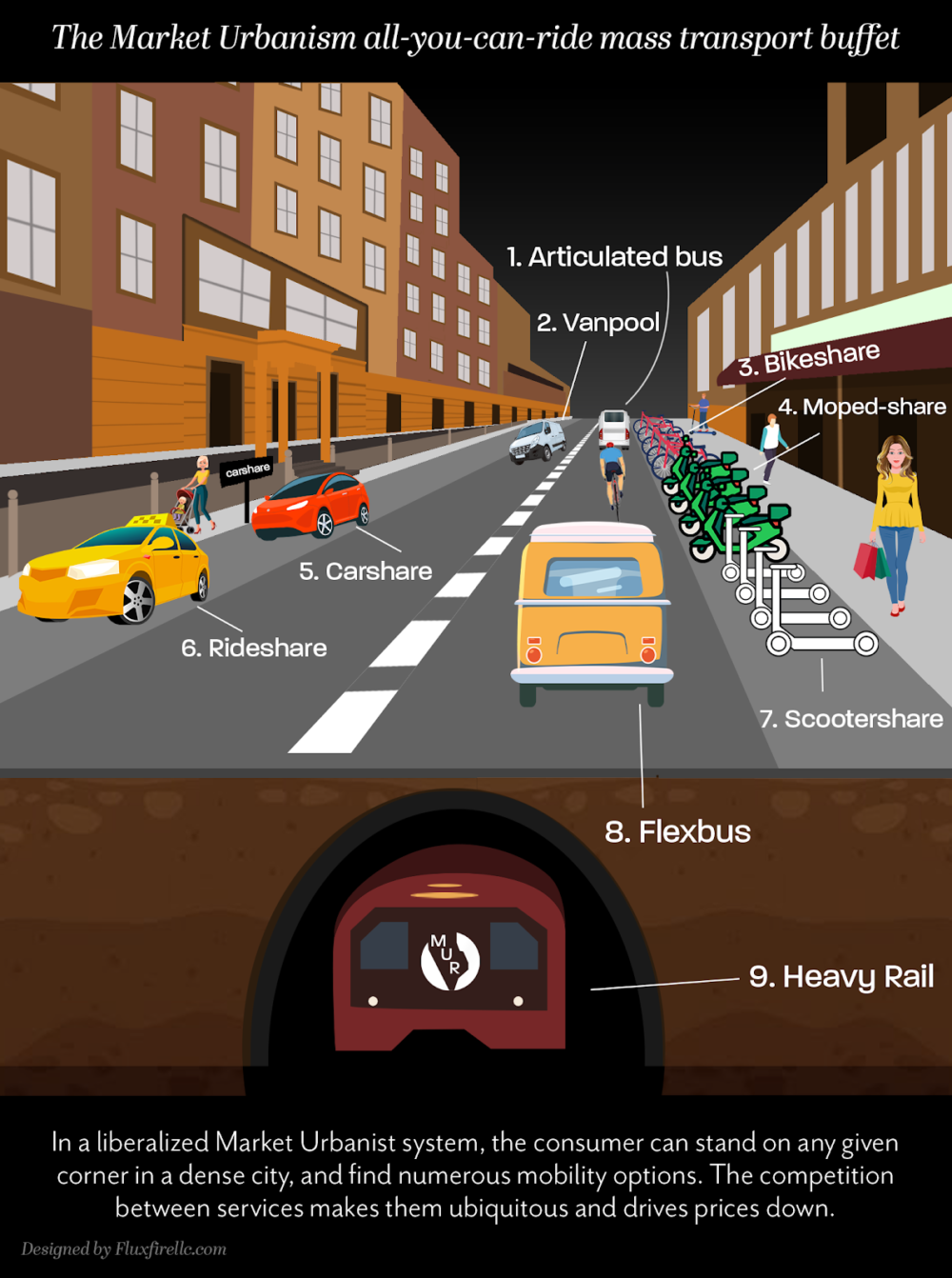How Would a Free-Market Transportation System Work?
This is the final article in a 7-part series on the privatization of transport
In this series I have described how private sector innovation can help micro-transport, buses, rail, roads, and public transit. But really I just scratched the surface. A near-endless wave of new technologies and services are improving the industry. It would be hard to list them all, but a random sampling shows how changes are happening from top to bottom.
Waymo, a Google subsidiary, has worked for years on driverless taxis and has now launched an AV e-hailing service in Arizona. Robots are set to revolutionize package delivery, from Amazon’s ground-level carriers to the numerous companies developing aerial drones. In 2017, flying cars became common in Dubai and now the government has approved designated sky lanes for them. In the U.S., a company called Scoop uses tech to streamline commuter “slugging”. The company Xtelligent is developing traffic signals that better communicate with AVs. “Smart bikes” now enable cyclists to detect traffic and prevent theft. Elon Musk alone is a one-man transport startup accelerator, sparking advances to tunneling, EVs, hyperloops, and aerospace engineering. The list goes on.
One criticism I have of everyday statist urban planning commentators is that they romanticize—and call to prop up—old ways of getting around. At the same time, they often hector new innovations such as those coming from Musk.
Free-market urbanists, by contrast, are positive about these innovations; they see transport as an industry that should wed traditional mobility with futuristic thinking. The industry should embrace continual change, innovation, and disruption—what economist Joseph Schumpeter called “creative destruction”—and the more it is allowed to thrive in this private sector model, sheltered from excess regulation, the more it will advance. After all, if a network of aging Tro Tro buses can carry 70% of commuters in Accra, Ghana, what improvements could be in store when applying modern tech to this service, in societies that are far wealthier?
In a market-oriented future we will find out, and the winner through it all will be the consumer.
Final Thoughts
To conclude, this series on market-oriented transportation theory has amounted to both a critique and a proposed remedy. It is a critique of our modern transport system, which is mostly government-run and thus suboptimal. Our system overwhelmingly subsidizes automobile ownership—at the expense of our economy, environment, and productivity—and is mismanaged due to its socialized nature. Public transit is also propped up, in part to reverse this car culture, but is inefficient due to the same public choice problems.
The free-market remedy to this government duopoly is to replace the current model with a privatized version. The definition of privatization here can be literal, meaning private sector provision of infrastructure and services, or can mean a P3 hybrid. But in either case, a private system hinges on two broad principles.
- Allocate urban ROW—namely roads and curbside parking—based on price signals, rather than giving it away to any one interest group.
- Liberalize the private transportation industry, so companies can openly bid for use of that ROW.
Were both policies to happen, I think we’d see (especially in dense cities like San Francisco) what I call an “all-you-can-ride mass transport buffet.”
Dense cities, after all, are full of people who live car-free, are public-transit-dependent, have long commutes, and who generally feel “stuck” by their lack of mobility. There is heavy demand among them for nifty ways to get around. Private companies, seeing financial opportunity, and no longer facing regulations that hold them back, would flood the market with options. But the competition between these companies would force them to keep prices low, services on-time, and coverage ubiquitous.
In the illustration below (drawn by Market Urbanism Report design staffer William Miller), we depict how this might work on any given city block. Standing on the corner, the consumer has the choice between riding shared bicycles, scooters, mopeds or cars; hailing rideshares, vanpools or small flex buses; or taking large articulated buses or rail, be they public or private. (Not included in this illustration, but perhaps just as relevant, are the technological innovations listed above. Even if commercial hyperloops and delivery drones aren’t available now, in a decade or two they could render obsolete some of what was added to this drawing).

Each of these services would exist because they would have had an opportunity to bid for their respective space in the ROW, even resting side-by-side along the same curbs. The variety and competition would make these services accessible to all income groups, with trips costing as little as $0.25 per trip.
What cities would have then, in this “mass transport buffet”, is a system where mobility improves for millions of residents. They can get from point A to B cheaply across their city, with multiple options available from block to block.
This private model may sound theoretical, in that it has not been tried to this extreme. But there are partial examples worldwide, from Mexico City to Tokyo and points in-between. If this “buffet” model feels foreign in the U.S., it is because for transport we are far less market-oriented than those places. The way to reverse that is for city governments to finally legalize the transportation industry.
Catalyst articles by Scott Beyer | Full Biography and Publications
